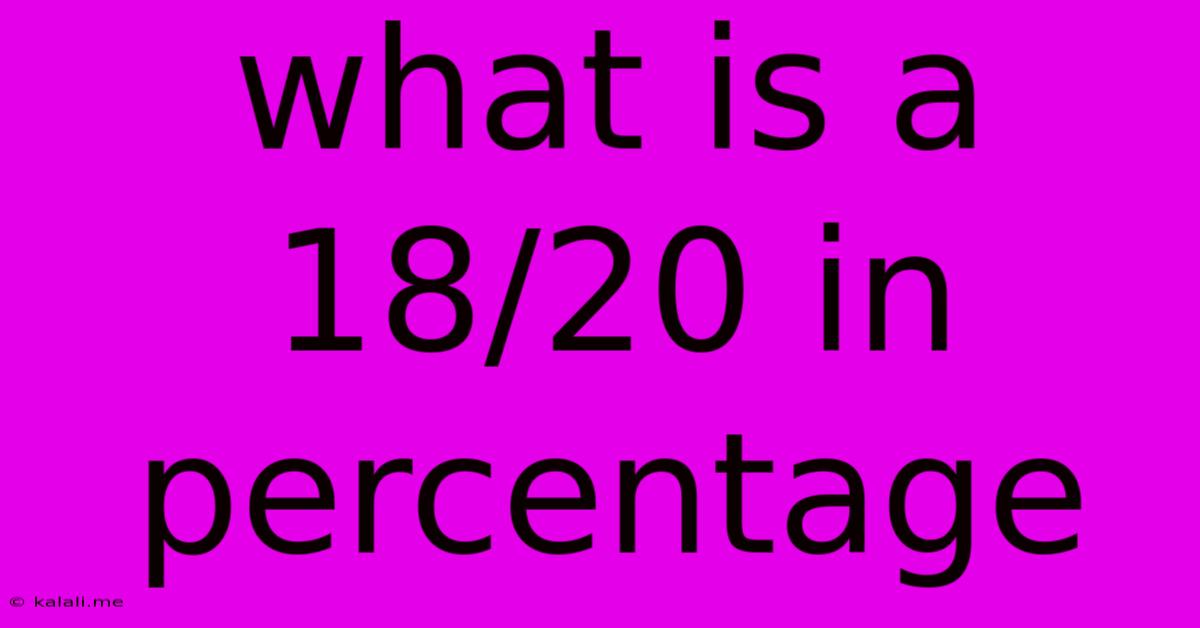What Is A 18/20 In Percentage
Kalali
Apr 23, 2025 · 4 min read

Table of Contents
What is 18/20 in Percentage? A Comprehensive Guide to Fraction-to-Percentage Conversions
Understanding how to convert fractions to percentages is a fundamental skill with applications spanning various fields, from academic grading to financial calculations and data analysis. This comprehensive guide delves into the process of converting the fraction 18/20 into a percentage, explaining the methodology in detail and providing practical examples. We'll also explore different methods for fraction-to-percentage conversion, enabling you to tackle similar problems with confidence. By the end, you'll not only know the answer to "What is 18/20 in percentage?" but also possess the knowledge to perform these conversions independently.
Understanding Fractions and Percentages
Before diving into the conversion, let's establish a clear understanding of fractions and percentages. A fraction represents a part of a whole, expressed as a ratio of two numbers: the numerator (top number) and the denominator (bottom number). The denominator indicates the total number of parts, while the numerator indicates the number of parts being considered.
A percentage, on the other hand, represents a fraction of 100. The symbol "%" denotes "out of 100" or "per hundred." Percentages are widely used because they provide a standardized way to compare fractions with different denominators.
Method 1: Direct Conversion using Division
The most straightforward method to convert a fraction to a percentage involves two simple steps:
-
Divide the numerator by the denominator: In our case, we divide 18 by 20: 18 ÷ 20 = 0.9
-
Multiply the result by 100: This converts the decimal to a percentage: 0.9 x 100 = 90%
Therefore, 18/20 is equal to 90%.
Method 2: Simplifying the Fraction First
While the direct division method works effectively, simplifying the fraction before conversion can sometimes make the calculation easier. This is particularly helpful when dealing with larger numbers.
-
Find the Greatest Common Divisor (GCD): The GCD is the largest number that divides both the numerator and denominator without leaving a remainder. For 18 and 20, the GCD is 2.
-
Simplify the fraction: Divide both the numerator and the denominator by the GCD: 18 ÷ 2 = 9 and 20 ÷ 2 = 10. This simplifies the fraction to 9/10.
-
Convert the simplified fraction to a percentage: Now, divide the numerator (9) by the denominator (10): 9 ÷ 10 = 0.9
-
Multiply by 100: 0.9 x 100 = 90%
As you can see, simplifying the fraction leads to the same result: 90%.
Method 3: Using Proportions
This method is particularly useful for visualizing the conversion and understanding the underlying concept. We set up a proportion:
18/20 = x/100
Where 'x' represents the percentage we're trying to find. To solve for 'x', we cross-multiply:
18 * 100 = 20 * x
1800 = 20x
x = 1800 ÷ 20
x = 90
Therefore, 18/20 is equal to 90%.
Practical Applications of Percentage Conversions
The ability to convert fractions to percentages is invaluable in numerous contexts:
-
Academic Grading: Many educational systems use percentages to represent student performance. A score of 18 out of 20 on a test translates directly to a 90% grade.
-
Financial Calculations: Percentages are essential in finance, used to calculate interest rates, discounts, profits, and losses. Understanding percentage changes is crucial for analyzing financial trends and making informed decisions. For example, calculating percentage increase or decrease in investment values.
-
Data Analysis: In statistical analysis and data representation, percentages provide a clear and concise way to present data proportions. This is particularly useful in surveys, polls, and market research. For instance, understanding market share, customer satisfaction rates, or conversion rates.
-
Everyday Life: Percentages are frequently used in everyday situations, such as calculating tips, sales tax, discounts, and understanding proportions in recipes or construction projects.
Beyond 18/20: Mastering Fraction-to-Percentage Conversions
Understanding the methods described above equips you to handle any fraction-to-percentage conversion. Let's consider a few more examples:
-
25/50: Following the methods outlined above (simplifying to 1/2, then converting to 50%), this equals 50%.
-
15/25: Simplifying to 3/5, then converting to 60%, this equals 60%.
-
7/28: Simplifying to 1/4, then converting to 25%, this equals 25%.
-
36/48: Simplifying to 3/4, then converting to 75%, this equals 75%.
These examples demonstrate the flexibility and applicability of these conversion methods. Remember to always simplify the fraction if possible to ease the calculation.
Troubleshooting Common Mistakes
Common errors when converting fractions to percentages include:
-
Incorrect division: Double-check your division calculations to avoid arithmetic mistakes.
-
Forgetting to multiply by 100: Remember that the final step is crucial to express the result as a percentage.
-
Misinterpreting the fraction: Ensure you correctly identify the numerator and denominator before proceeding with the conversion.
Conclusion
Converting 18/20 to a percentage yields 90%. This guide has provided multiple methods for achieving this conversion, highlighting the flexibility and importance of understanding the underlying principles. By mastering these techniques, you can confidently tackle various fraction-to-percentage conversions in academic, professional, and everyday situations. Remember that the key is to understand the core concept of representing a part of a whole in different formats and choosing the method that best suits your needs and the complexity of the fraction. Practice makes perfect, so keep practicing these conversions to further solidify your understanding.
Latest Posts
Latest Posts
-
What Percent Is 21 Of 50
May 09, 2025
-
Which Event Marks The Beginning Of A Supernova
May 09, 2025
-
56 Cm Equals How Many Inches
May 09, 2025
-
How Much Is An Inch And A Half
May 09, 2025
-
How Many Cups Is 21 Ounces
May 09, 2025
Related Post
Thank you for visiting our website which covers about What Is A 18/20 In Percentage . We hope the information provided has been useful to you. Feel free to contact us if you have any questions or need further assistance. See you next time and don't miss to bookmark.